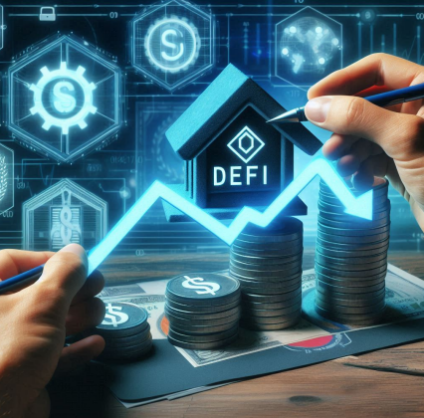Decentralized Finance or DeFi is disrupting the financial system. Especially, DeFi lending is led at the head, giving access to loans around the world to everyone, without needing to involve traditional banks. As a peer-to-peer (p2p) architecture using the blockchain, this paper is dedicated to democratization of credit, increase of transparency and simplification of credit operations. But what is DeFi lending and what technology is it and why is it pitched as a game changer for financial inclusion? Let’s explore.
What is DeFi Lending?
Borrowing and lending in DeFi makes it possible for users to interact directly with each other without the middlemen (banks). Instead, automated agreements, self-enforcing contracts are carried out by smart contracts-self-learning agreements on the blockchain. These contracts guarantee secure, automatic execution do not depend on trust in a central authority. For instance, Aave, Compound, and MakerDAO provide platforms for lending (users put a crypto asset in exchange for interest or a crypto asset pledging as security to obtain a loan).

Traditional vs. DeFi Lending: A Quick Comparison
Feature | Traditional Lending | DeFi Lending |
Accessibility | Limited by geography, credit scores | Open to anyone with internet access |
Intermediaries | Banks and financial institutions | No intermediaries, fully decentralized |
Approval Time | Days to weeks | Minutes to hours |
Transparency | Limited insight into processes | Full transaction transparency via blockchain |
The Financial Impact of DeFi Lending
- A Growing Market: DeFi lending is rapidly expanding. DeFi Pulse indicates that as of November 2023, total value locked (TVL) in DeFi lending exceeded $75 billion from $45 billion in 2022. This increase is a result of the confidence in decentralized schemes and reflects the evolution towards decentralized lending.
- High Returns for Lenders: A major attraction of DeFi lending is the potential to deliver a higher return to the users than can be achieved with traditional savings accounts. Payments e.g., can be received on platforms, like Aave and Compound, with APY (annual percentage yield) ranging from 3% to 10% based on the cryptocurrency and market demand. By contrast, APYs on savings accounts are usually less than that of lending institutions (less than 1%).
Benefits of DeFi Lending for Financial Inclusion
- Access for the Unbanked and Underbanked: The World Bank calculates that there are approximately 1.4 billion adults around the world who are unbanked. In traditional financial systems, admission is denied for the lack of registration proof, negative credit history or for being from a specific area. DeFi lending overcomes these obstacles, and all that is required is an internet connection and a digital wallet. They are a replacement for predatory lenders that are infamous for exploiting customers with punitive interest rates. Particularly, borrowers in Africa have already begun to utilize DeFi platforms such as Celo to get microloans, which in turn minimizes lending to local loan sharks.
- No Credit Score Requirements: DeFi lending does not depend on credit history but instead on collateral, which in turn facilitates loan access for poor (or even no credit) people. Borrowers are allowed to pledge up against their crypto assets as collateral and obtain a car loan instantly without credit check. For example, a person who holds $10,000 worth of Ethereum (ETH) is able to use it as collateral on a DeFi platform in order to receive loans. This is an option for entrepreneurs and other needy individuals who would otherwise not qualify for financing from mainstream institutions.

Risks and Challenges in DeFi Lending
- Smart Contract Vulnerabilities: Although smart contracts are programmable, they can be subject to bugs or defects. A bug in code can lead to massive losses. In 2021, a DeFi platform suffered a $600 million hack due to a smart contract vulnerability. Although, ultimately, most losses were restored, this experience emphasizes the value of unified audit tracks and strong security safeguards.
- Volatility and Liquidation Risks: Cryptocurrencies are known for their volatility. Liquidation is the risk carried when a significant portion of the value of collateral deteriorates. Specifically, if a borrower deposits a $1,000 bitcoin pledge, and the market value goes down by 30%, the loan may be liquidated to settle the claimed loss. To mitigate this, many DeFi platforms require over-collateralization. Borrowers are mandated to at least match the loan amount with a 150% (and subsequently increased) deposit in addition to their loan when taking out a loan, thereby reducing the risk that the lender is putting up and so also reducing the amount of information that can be used by the lender.
- Regulatory Uncertainty: DeFi is working in an unrealistically unchartered area with risk for its borrowers and lenders. Regulatory environments are still dynamic and future amendments could impact the availability and legality of DeFi services. Increased regulatory clarity, on the other hand, may make trust and adoption more attractive.
Notable DeFi Lending Platforms
- Aave: It is one of the most widely used DeFi lending platforms, famous for its flash loans—flash loans that are uncollateralized and with a mandatory settlement timeframe of a single transaction. Aave supports multiple cryptocurrencies and offers competitive interest rates. Aave topped $10 billion Television Lending Volume (TVL) in 2023 as a pioneer in the DeFi space.
- Compound: With Compound, its users can earn interest on their crypto by lending the crypto to liquidity pools. The platform employs an algorithm, logic of supply and demand, that may dynamically change the interest rate. Governance token for Compound, "COMP" allows the platform to vote and also creates a decentralized community.

The Future of DeFi Lending
DeFi lending is in its infancy, but it is also able to be quite potent. Due to the advance of blockchain technology as well as the availability to the digital assets, DeFi lending may become one of the mainstream financial services. In particular, emergence of innovations, such as cross-chain interoperability and layer-2 scaling, has been forecasted to enhance the efficiency and scalability of DeFi platforms. Furthermore, potential integration of relationships between retail financial institutions and DeFi technology could support the expansion of the opportunity all the way to a smooth transition from centralized to decentralized finance. DeFi lending is grand innovation in the spread and availability of loans. DeFi applications are paving the way for a fairer financially world, not through a disintermediation of effects, but reducing transaction costs and improving accessibility. However, despite the risks, the opportunities of being part of this new financial world are clear. Revenue generated from DeFi lending may alter the game of financial worldwide, transforming it towards equity and efficiency.





